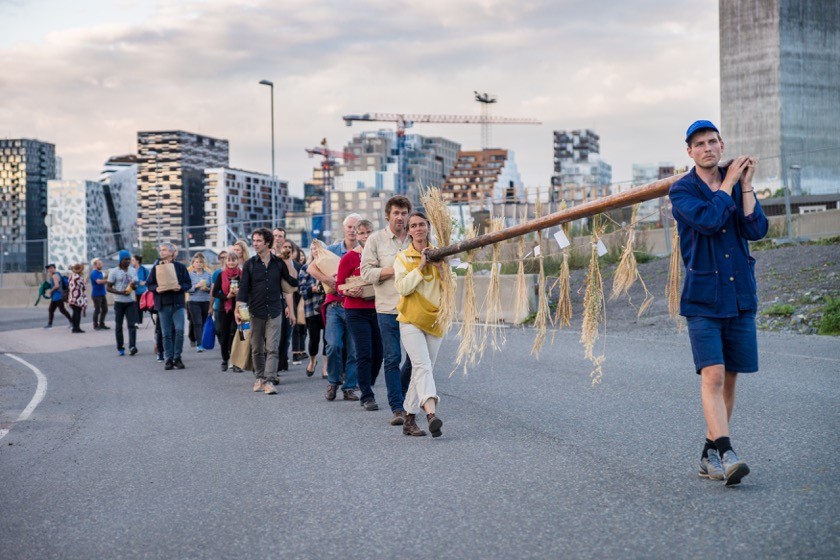“This journey to the Middle East can be seen as an awakening of the memory—the long journey the grain itself has taken—through the hands of time.”
— Michael Taussig, Now Let Us Praise Famous Seeds
Since their founding by Amy Franceschini in San Francisco in 1995, the collective Futurefarmers have presented subtle, complex, and multifaceted, public works delving into the nature of collaboration, publics, nature, science, and tools such as media and culture. This past March, co-curator Kendra Sullivan and I invited the multi-member collaboration to participate in Resistance After Nature, an exhibition we curated for Haverford College in Pennsylvania. At the same time, the group had installed an ambitious new project at the Carpenter Center for the Visual Arts at Harvard University, and was preparing to launch the second leg of their ocean-travelling Seed Journey (2016-) a voyage on a 19th century Norwegian rescue ship to retrace the path that ancient grains travelled from Turkey to Norway thousands of years ago.
The work we included in Resistance After Nature documents a public ceremony and action in which soil from over 50 Norwegian farms was brought to Oslo to build the foundation of the Flatbread Society Grain Field and Bake house and lay the groundwork for an urban garden and food-oriented cultural institution, Losæter, located on public land along the waterfront in Bjørvika, Oslo. The project, initiated by Futurefarmers’ Flatbread Society, transformed an underutilized plot of land into a permanent stage for art and action related to food production, gardening, herbalism, community, and urban ecology. In related activities, Futurefarmers planted, tended, and harvested a grain field made up of nine varieties of heritage grains, built a floating “canoe oven” followed by a permanent bake house, led activities with the public around farming and food production, and, finally launched Seed Journey.
Over the past few months, I had the opportunity to speak with Futurefarmers Amy Franceschini, Audrey Snyder, and Joe Riley, by email, Skype, and phone about their sprawling practice and co-temporal projects. What follows are reflections culled and reassembled from our hybrid conversation on their expansive practice. 1
- The bulk of my conversation is from a single Skype interview with Audrey and Joe in April. One point Audrey and Joe wanted to be sure to make is that they were speaking as participants in Futurefarmers and not necessarily for the group. As Audrey put it, “it’s very rare in an art context where you get to participate both as artists within your own right but then you’re also given this opportunity to collaborate in a very intense and in-depth way, but these are really our reflections on the project, and others involved might have different takeaways from what we’ve lived and made together.”
Dylan Gauthier: Dear Futurefarmers, I’m writing these questions to you while seated in the Motto shop (Consumer Research Center) at the Carpenter Center for the Visual Arts at Harvard University in Cambridge, MA, where I came to see your exhibition Futurefarmers: Errata—Brief Interruptions. Where in the world are you now? What are you doing?
Amy Franceschini: Belgium. We’re provisioning for Seed Journey’s second leg launch, summoning Bruegel’s ghost and rain.
Joe Riley: Whitney ISP studios. Supporting and working on SJ from the NYC-side.
Audrey Snyder: NYC. Preparing to join Futurefarmers in Antwerp, Belgium. Provisioning for the second leg, sourcing food and connecting with farms for the journey.
DG: By all accounts Ff’s work (and the collective itself!) is sprawling – you have this show up at CCVA Harvard that traces errors, wanderings, interruptions, bugs and grains… there are Futurefarmers working all over the world. Ff is launching the second part of Seed Voyage which itself ties into an earlier work, Flatbread Society, which was started in Oslo, Norway and remains as a functioning community garden site.
JR: Futurefarmers is a broad constellation of collaborators and the work traverses many interests, edges, and centers. It is an ecology of practice rather than an iteration of one project after the next. The Flatbread Society work was a catalyst for Seed Journey and SJ in turn has feedback into the public Bakehouse site, the farm, and community garden in Oslo. Common threads run through work, such as, well, the commons, and peeling back regulation in space and time.
AF: There are several threads that run through Ff, as we work in various assemblies of collaborators depending on the time and place of a project. One thread is Flatbread Society, which is a durational questioning of the commons through the lens of grain. Seed Journey is an extension of this and the work at the Carpenter Center is a portrait of works created by Amy Franceschini and Michael Swaine between 2010 and present.
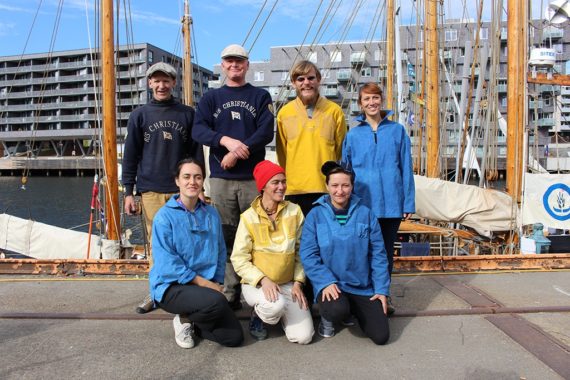
DG: Was the launch of Seed Journey last year your first time working in Norway?
JR: Futurefarmers has been working in Norway since at least 2012 via Flatbread Society, which emerged via Ff’s participation in Slow Space Bjorvika, curated by Claire Doherty and her curatorial project Situations, which brought us to the Oslo waterfront.
AF: We formed Flatbread Society as a proposition for working with local people to establish an aligned vision for the use of this land. In 2014, an official renaming of the site was established. The collectively coined name “Losæter” draws from the Norwegian words “Loallmenning” and “sæter.” “Allmenning” defines an area of land that is put aside by the state for recreational activities; it also defines an area that is in private or official ownership, where others than the owner have rights to use the area, for example, traditionally allowing livestock to graze on the land. And “sæter“ refers to one house or a collection of houses traditionally used as a summer dairy farm in the high mountains. A right to sæter implies the right to put animals to pasture and to put up a mountain pasture house.
“Losæter” combines these two terms to connect Norway’s agricultural heritage to the present, extending the metaphor of cultivation to larger ideas of self-determination and the foregrounding of organic processes in the development of land use, social relations, and cultural forms. The openness and fluidity of the projects evolving at Losæter stand in stark contrast to the rational logic of development in the surrounding areas of Bjørvika. Situated amongst the National Opera, the Munch Museum, Deichmanske Library and the National Stock Exchange, Losæter is charged with questioning our relationship with the land, namely cultivation of land as a relevant, cultural endeavor that includes the production and management of common resources.
DG: Though Ff’s work is quite conceptual in practice, it is usually focused around some kind of material (shoes, grains, bricks, bread) as well as relationships built on those materials – public space, food systems within specific sites. You often engage in what I will call for lack of a better phrase “reverse re-engineering” – taking something apart so you can put it back together using an entirely different kind of material, which often re-engineers our thinking about the original in the process. How much are you concerned with how we make things today? Is your work offering models or suggestions of how “things” might be made, and understood otherwise?
AF: Seed Journey, which is sailing from Norway to Istanbul, draws attention to the co-existence of agents, human and non-human, that tend the land and protect the right to share seeds and knowledge openly. The re-tracing backwards of the routes of these seeds and their cultures re-signifies these voyages from the 21st century vantage of having lost our flotation, lost our way; a “reverse Nansen,” “reverse Humboldt,” reverse “Darwin,” Cook, Magellan or whatever traveller you may want to choose.
DG: What are the next steps in the project for you?
AS: I’m heading to Antwerp next week for the launch. Amy is there now with Lode Vranken, Marthe Van Dessel, and Martin Lundberg making preparations for the voyage. So far, the grain has been loaded onto small boats, one of which is a canoe-oven, and canoed down the river to Antwerp.
The following weekend we’ll bring everything to the RS Christiania. We’ll leave Antwerp on the 18th and will head to Jersey Island, where we’ve been invited to come and do the first research trip in a year-long residency. 1
- RS 10 «Christiania», the Norwegian rescue ship.
DG: Is this a new residency project on the Island?
AS: Yes. It’s a new residency called the Morning Boat Research and Production Residency which is hosted by Jersey Arts Trust and curated by Kaspar Wimberley and Susanne Kudielka. Kaspar and Susanne invited us to Jersey Island because Jersey has historically been a seafaring hub, and there’s also an agricultural/culinary revival going on right now on the island. There’s a beer and cider making community and a farming community. There’s a diverted stream that runs an old water mill on the island called the Quetivel Mill.
JR: This is the first stop for Futurefarmers at Jersey Island – a research expedition – but the residency will continue in the coming year.
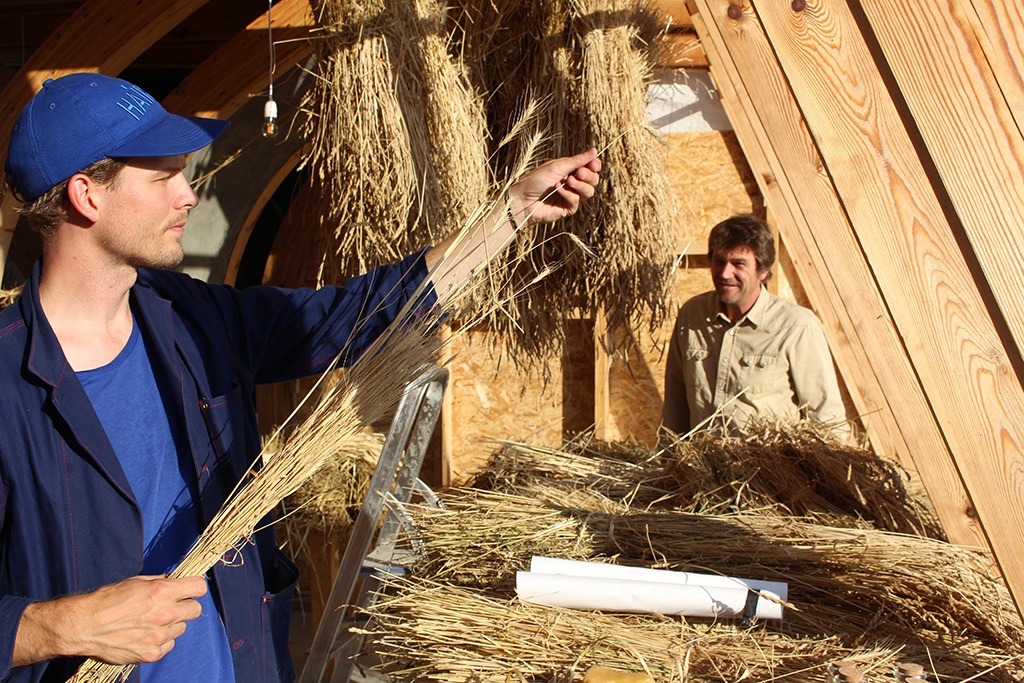
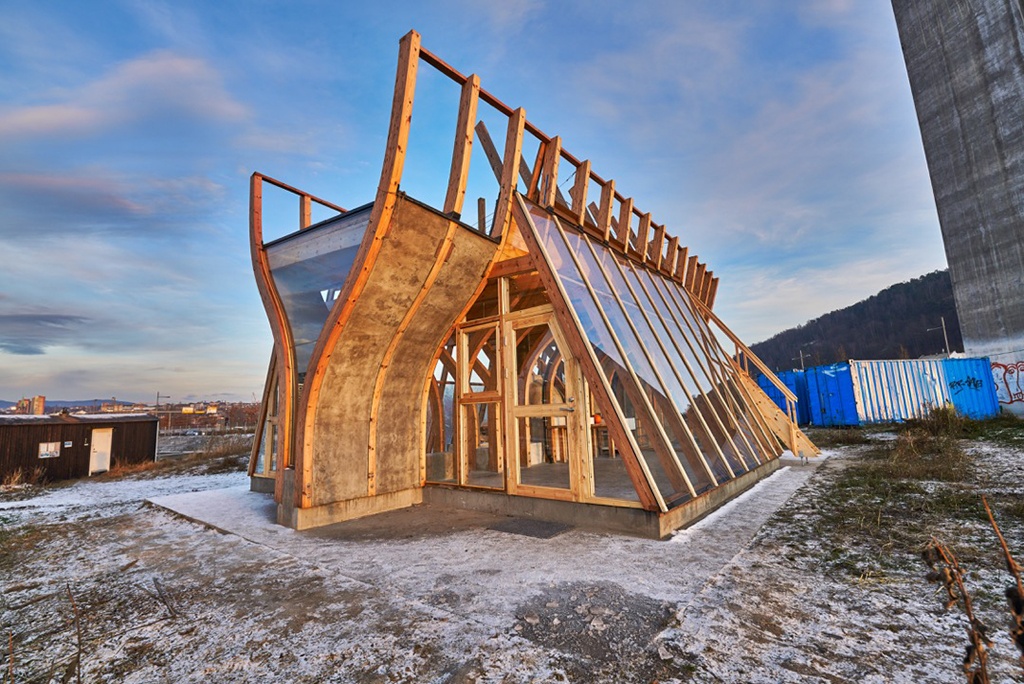
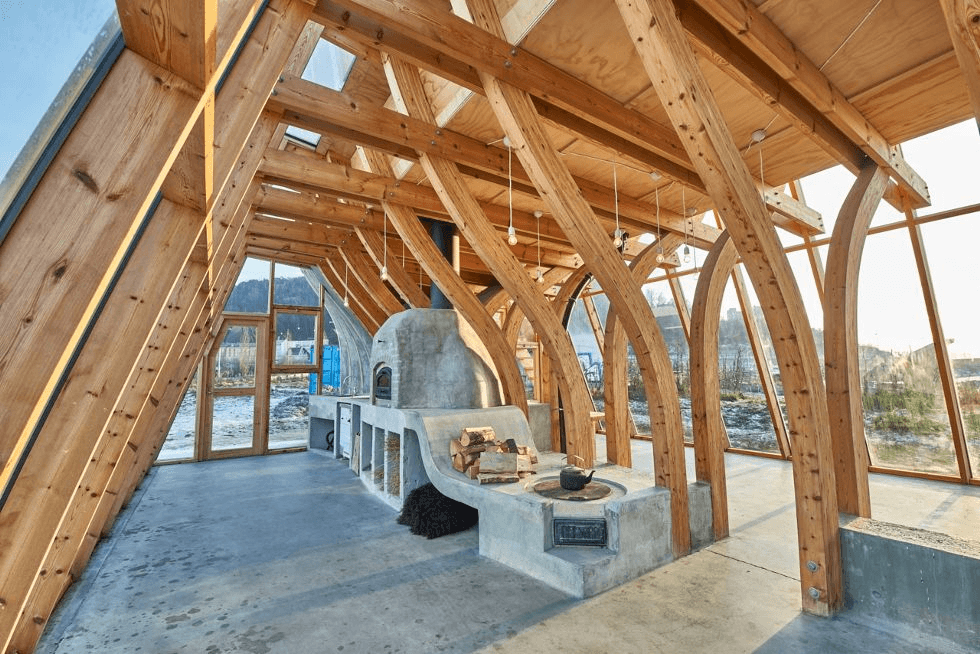
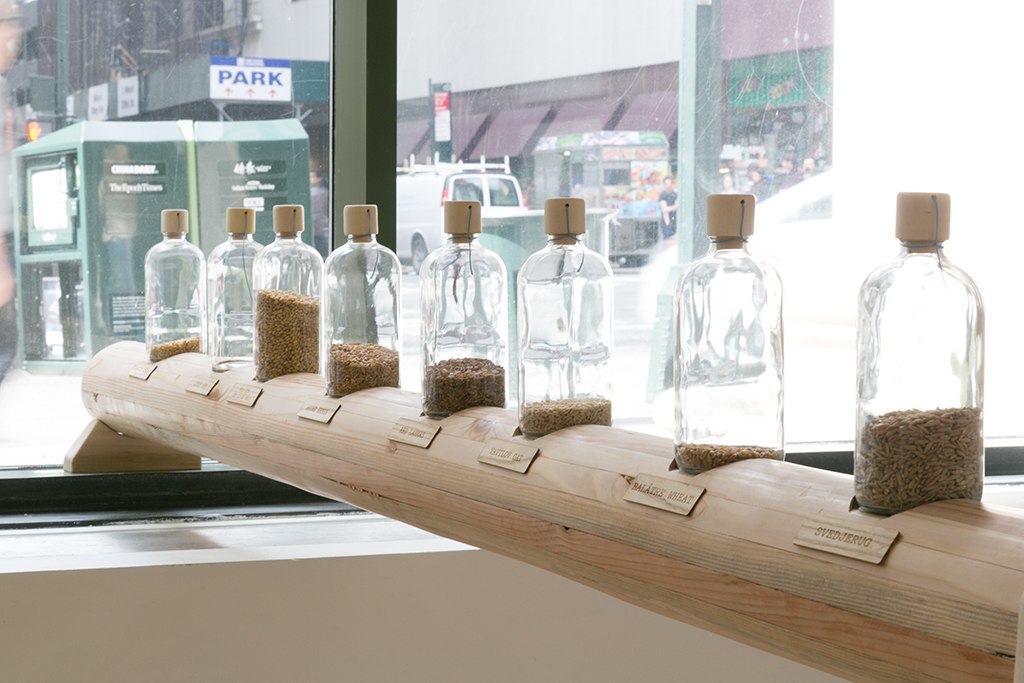
DG: What happens at the site in Oslo?
AS: Flatbread Society proposed that the activity of making flatbread and all of the threads that lead into that process are actually the purpose of the bake house, which is also the art practice. It’s thinking about the commons, and culture and what it means to be in a space together through the activity of making bread, whether by inviting people who are growing the grain to the space…
AF: We took the tradition of Norwegian commons to heart in this project and wanted these ancient grains to symbolize the biological commons that are currently at risk due to the privatization and commodification of our seed stock.
JR: In that context it has a relationship to the commons, but then eventually it was a working harbor and a port for a long time and then became postindustrial and is now being redeveloped–
AS: As real estate–
JR: Oslo’s largest redevelopment project ever. It’s called the “barcode” project.
DG: Barcode?
JR: Yeah. Visually it looks like a barcode of buildings, this was the backdrop to the area where the Flatbread Society project is. Slow Space Bjorvika invites artists to do long-term public programming and projects connected to various sites in the area. The Losaeter site that Futurefarmers focused on was eventually going to be turned into a sports field or some default developer’s notion of what public space should like. But the work of FBS in that site has been transforming the imagination of that space and has been moving and changing its trajectory into what it is now, a permanent public bake house, a farm, etc.
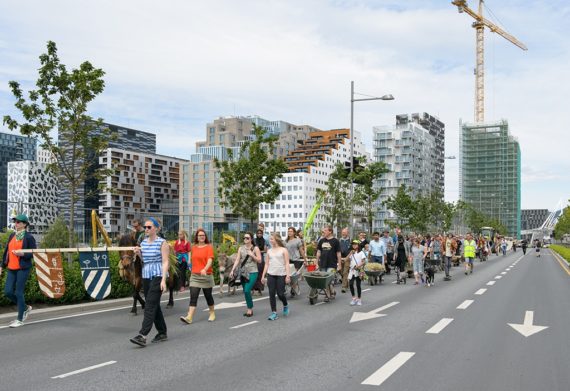
DG: So it’s no longer going to be a soccer field?
AF + JR: It will be a farm!
DG: So in some way, Flatbread Society interrupted the process that was about to take place on this site. Can you talk a little more about how “interruption” figures in your work.
AF: I have never referred to our work using this word. If we do provoke a sort of “interruption,” I would say we work to synthesize with a situation, people, place – to slip into a “uniformity” or tradition or flow such that our action might seem recognizable, but once entering into it, expectations are turned over, strangers meet, and new configurations of engagements emerge. We use pre-existing forms, frameworks, and subtly shift them, as with our Soil Procession in Oslo. The form is immediately recognizable as a parade, but the content is confused or unexpected. Some say we are tricksters in this sense. Lewis Hyde describes the trickster as a “boundary-crosser.”
JR: I often think of the work of Ff as a bug in the machine. It is not so much an “interruption” in the sense of monkey-wrenching activist strategies (my association) as it is a way of producing new knowledge via friction. Like Amy writes above, entering into pre-existing forms and institutions is key. Ff works towards producing this kind of productive friction through non-mastery – and pairing forms that are at once recognizable (sailboat, museum) with forms that are increasingly backgrounded (agrarian ritual).
DG: Futurefarmers’ Flatbread Society uses grain as a prismatic impetus to consider the interrelationship of food production to realms of knowledge sharing, cultural production, socio-political formations, and everyday life. As Ff has written, “the seed is a stand-in for what we share, and for what we stand to gain by sharing – not just seeds but knowledge of survival, health, and a locally-oriented connection between our bodies, our food, and the land.” Can you expand on this thought?
AS: One of the actions related to Flatbread Society that we both participated in was Soil Procession. The idea was that we wanted to establish the grain fields as a site for people to be able to come and use it collectively, so we did this soil building activity, with farms from all over Norway and Scandinavia, some from Denmark and Sweden. We processed the soil through the city and it ended up on the site. There’s a lot of emphasis on bringing in resources, so that the site functions as a focus point for all of these different projects and places that are happening throughout the region. The grain that is grown there is also being grown all throughout Norway.
AF: A procession of soil and people through Oslo drew attention to this historical, symbolic moment of the transition of a piece of land into a permanent stage for art and action related to food production. At high noon, farmers gathered at the Oslo Botanical Gardens joined by city dwellers. Tractors, horses, wagons, wheelbarrows, musical instruments, voices, sheep, boats, backpacks, and bikes proceeded to Losæter, where the farmers’ soil offerings were laid out upon the site and the Land Declaration was signed. A small portion of the soil from each farm was used to make a series of clay vessels. These vessels will permanently reside in the bake house and serve as the Flatbread Society seed archive.
JR: The lead Futurefarmers on Flatbread Society have been Amy, Stijn Schiffeleers, Lode Vranken, and Marthe van Dessel. They’re the deepest in that particular work.
The soil procession video that is at Haverford emerged from the procession from all around Norway to the site. 1
- The Soil Procession video was produced by Futurefarmers in collaboration with videographers Alex Asensi, Andreas Luksepp, Anthony Harrison; Music: The Cafeteatret World Choir and NBX Theater School, led by Eli Storbekken, 'Rain and Soil' by Uniform Motion (uniformmotion.net); Partial funding for Soil Procession made possible by the U.S. Embassy in Oslo and the University of Washington, Seattle. For more information, visit flatbreadsociety.net.
AS: The project is also trying to understand a commons through the genetic diversity of cereal crops, and these seeds that have been left behind, or left out of industrialized agriculture, and as a result they belong to us all. They’re not genetically modified, they’re not patented, and they belong to the sites in which they were grown and propagated. They have all of these traditions and farming practices intact.
DG: How can a grain be a compass?
JR: The story that we’ve been telling all along is that the seeds are guiding the journey. The specific story of rescue and resistance; each of the particular grains that FBS and Ff have collected over the years has a story of rescue and resistance available on the Seed Journey website. Nikolai Vavilov, a Russian botanist and horticulturalist, is credited with forming the modern seed bank. Vavilov, a humanist, wanted to collect grain and food crops with the idea that no one will go hungry if he could preserve these different varieties of grains. He inadvertently created the first seed library: the Vavilov Institute in St. Petersburg. The oat Futurefarmers acquired from the library was saved during the siege of Leningrad. The scientists defended the seed library. To some extent we’re trying to push against that history. Our ideal of a place to protect and cultivate this material is the farm. As Seed Journey partner and farmer Johan Sward says, “We don’t need a museum for conserving varieties, what we want is to grow them.”
AF: The Latin root of the word “rescue” is to return.
DG: What grains are you carrying, and why are these particular seeds important?
AF: We started with a Finnish Rye. We came to this rye when searching for someone farming “ancient” grains in Oslo. The centerpiece of the work in Oslo is a grain field featuring ancient grains that have been rescued from interesting places. The rye was found between two boards in an old sauna used by the Forest Finns in the early 1900’s to dry their grains. Interestingly, the grain was thought to be lost, but an amateur archaeologist in the story rediscovered the rye. Each of these seeds have a particular story of rescue associated with them, and through the planting and exchanging of them, an awakening. For example, a variety of barley that we have with us came by way of St. Petersburg.
AS: Flatbread Society produced a video about the Rye that is being grown in partnership with the farmers Johan and Kristin Swärd in Norway.
JR: The emphasis of Seed Journey is moving away from the idea of seed as property that should be stored away, and that truly the best way for these seeds to live and to express themselves is by growing them rather than sequestering them in a highly regulated seed bank. So the idea of a journey, a mobilization, of grain is resistant to the notion of the seed bank. Instead it’s proposing that the better way for the seeds to be propagated and to express themselves is by growing them rather than storing and sequestering them away in a seed bank.
AS: When you take seeds and you put them away in a seed bank you’re actually not allowing the seed to change and adapt to the particular environment. When we were in London we met with seed geneticist Andrew Forbes and he also feels strongly about this. His aim is to create multiple forms of resistance. Allowing these seeds to grow in response to their environment makes them more resistant and adaptable.
DG: As Seed Voyage travels back to Turkey, is the idea primarily to circulate these grains to farmers along the way?
AS: We’re talking about it as a hand-to-hand network, so in each place we show up and have a seed ceremony that is devoted to the grains. We hold this ceremony, where we ask about the story of where it’s grown and a little bit about the history and we interview the farmers and anyone else connected to its propagation. It’s not just collecting the grain but it’s trying to understand how that grain is viable in the place that we are. So that is about a network of people who are doing similar work in different countries, who are trying to create different economies for the grain so that it can grow in those regions.
JR: I like to think of it as a slow synapse firing across all of these networks that have existed and persisted for years, even centuries. Seed Journey is not necessarily the formation of a new platform, it is a return to an older one.
AS: We’re not asking anyone to grow our grains.
JR: But it is drawing tangential lines between these farmers and land stewards all over. You mentioned the destination of Seed Journey, talked about the idea of going backwards or retracing… that element has to do with the histories behind each of the particular grains. A lot of them point to specific notions of origin, whether it’s the story of where a particular grain originates from or where civilization originates from (in the fertile crescent, for instance, where some of the oldest grains have been domesticated). But there are many of competing origin stories. So part of the story is trying to peel back some of these stories and in some ways mirror that journey northward of a particular grain’s so called point of origin towards another location, a new origin. In order to follow this trajectory, Futurefarmers has embarked on a reverse journey.
DG: What does “phylogeny” mean in the context of your project? I see this as a keyword in Ff’s Flatbread Society and Seed-related projects but am curious how you, or the work, relate to it.
AF: Phylogeny is tracing an organism’s development, change, story through time. [It’s] a way of tracing and seeing the cosmology of interrelationship of food production to realms of knowledge sharing, land use, cultural production, socio-political formations and everyday life.
JR: Also, just to add that the name of the group “Flatbread Society” has to do with this idea that there are numerous cultural traditions that have a flatbread recipe or practice of some kind, and that it’s something that people can gather around across cultures and practices.
AS: The project has these different veins. The FBs are people who are involved in lots of different practices of making, whether it’s art making or beer or bread or it’s someone who knows how to make traditional flatbread from their grandmother. And then the bakehouse functions separately. The structure is in the shape of a boat, there are all these nesting ideas of how that bakehouse can hold all of these different conversations and the activity of making flatbread. And then there is the demonstration field which is on the same site. The artwork for me is the events, is the parts that cross amongst those three things. The Oslo site was also the end point for an anti-GMO march in 2013, so all these different things end up arriving at the Seed Journey site.
DG: Your work at CCVA starts from a well-known Errata in Marcel Duchamp’s book on chess. What parts of the work connect to Duchamp for you?
AF: Errata emerges from an evolution in our trajectory of work. As younger artists, we fancied the “readymade” – this idea of taking something from everyday life and putting it on a pedestal and calling it art. This was liberating somehow; the idea that everyone or the everyday was significant as an artwork. As we started to work with art institutions and their constraints/bureaucracy, we become more interested in Duchamp’s idea of the “reverse readymade” – taking a Van Gogh painting out of the museum and turning it into an ironing board, taking the rarified object and putting it back into the everyday.
Yet, further, as we worked more with art institutions and the white box space, we found a role for them within our work. While most of our work is extremely social and welcomes the mess of the everyday, the white box offers us a space to distill this chaos and to reflect on the more active/performative work we do. It allows us to present the formal aspects of our actions as tools or props that are essential in the aesthetic ecology of our work.
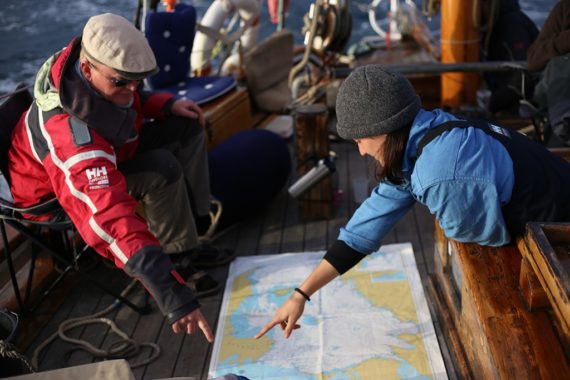
DG: So much of this work is conceptual, abstract, poetic, but I imagine the part of the work that is building a farm or sailing a ship must be more practical, more concrete, to some extent. Can you describe the experience of sailing in relation to the project?
AS: This is the strongest experience I had… so, the things we’re talking about growing, building a site that works for a community, and organizing communities that work and are going to keep working – those timescales are actually long and they are slow, and being out on the boat mirrored that. It really changed the timescale of what we were doing. To specifically pinpoint the feeling, what that feels like, when you arrive somewhere, you’ve travelled there by boat, it makes that experience very intentional. Somehow that intentionality – it’s hard to describe – the slowness and being forced to pay attention to the actual drift, and understand that the movement was really slow, deliberate, and at the whims of the winds and tides.
Sailing also allowed us to spend a lot of time with people in their spaces, on their farms when we landed, with the grain they were growing. We get to see what these communities are up to at each point. When we were in Denmark, for example, we had talked to the farmer who we were going to see quite a bit ahead of getting there. But when you go there and start talking to people, the story grows and bifurcates and builds outwards. This doesn’t happen when you’re just reading about it and writing or communicating through email. You have to be there walking around with grains in your hands – literally just walking around the countryside with grains in your hands.
JR: And when the project sails into a harbor it has this lovely and compelling story: we came by sea.
AS: It’s not unusual that people travel around by the sea, but an older wooden sailboat makes people understand that these seeds have travelled.
JR: There’s a Doug Tompkins quote, one of the founders of North Face, who died last year. He described the Seed Journey project as a “Barefoot Technology.” It’s an interesting way of thinking about sailing vessels, and of Futurefarmers’ entire practice of re-enacting, re-inventing…
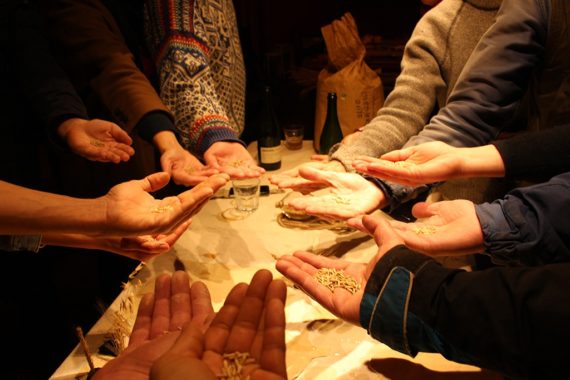
DG: “Barefoot Technology” feels dated, like a fragment of the 1960s, Whole Earth Catalog, a techno-futurist back to the land…but obviously still very relevant if we’re looking for alternatives… it is something familiar but also something potentially new.
AS: Yeah. There is the immediacy of something being already figured out and tried and true. There’s no mechanical assistance on the riggings on the boat. There’s a choreography that’s so specific to that type of boat: the coiled ropes, to watch them move rope around, and pull up sails.
I had a similar moment when we went to visit the farm in Denmark and the farmer was describing plowing his field, with an old tractor and to prevent the tractor from having wear and tear, he would sow and plant all of his grain fields in concentric circles so he wouldn’t have to stop and turn at the end of a row. So there are all of these consistencies that you only notice while you’re there. And you see that same type of knowledge when you go onto the land and you see people farming and kneading bread and baking.
JR: I don’t know if everybody else would agree with me on this but for me there’s also a sort of doubling down on romanticism. Maybe romanticism is a dirty word, but I think there is possibility for recuperating it. I can feel that the project is doing that a little bit. Allan Sekula talks about the imagination of the panorama of the sea. And how those of a sea faring vessel or culture develop. In some ways I think Seed Journey is treading those same waters. Michael Taussig writes: “The return of ancient seeds is like reverse engineering, taking apart this long history fold-by-fold. This voyage is an allegory, one forever open to chance. Our participation from afar breathes wind into the sails of the future.”
DG: What about the reasons you’re making it – Obviously you couldn’t be making this voyage in the past.
JR: This has to do with the urgency; a voyage that is necessarily slow in its urgency, and bundled up in contradiction through that process. For example, one thing that I think about a lot is the particular seed bank in Norway. It’s the first time that any seeds have been withdrawn from it.
AS: And all those seeds went back to a Syrian seed bank. They didn’t think that the seeds would have to be taken out.
JR: It’s literally the doomsday seed bank, the worst-case scenario. And yet here we are. It’s so present, it’s hard to think about or describe it.
AS: And there’s an urgency to describing what an economy around open pollinated seeds looks like. I think people know about GMO seeds now but it’s a little fuzzy when you’re actually standing in a field. It’s is a contradiction that I was interested in researching.
JR: These urgencies are reflected in the in the work of SJ crew members For example, Vivien Sansour is a collaborator and participant who runs the Palestinians seed bank that works with farmers in Gaza to continue cultivating land as a form of resistance and survival. Ignacio Chapela, a scientist and geneticist based at UC Berkeley, has done an immense amount of work regarding indigenous maize in Mexico, and how those crops have been encroached upon by GMOs and agribusiness. We’re also working with genetic scientists at [University of Wisconsin] Madison to try to better understand from a scientific and rational framework where these grains are coming from.
AS: And on the other end of the spectrum, the anthropologist Michael Taussig is giving us context about how these different registers of projects are happening.
DG: I’m curious to hear how you place a project like Seed Journey within a larger landscape of contemporary practice?
AF: It is very aligned with Cape Farewell or Hüseyin Bahri Alptekin’s Sea Elephant Travel Agency, a “floating laboratory” that followed the travels of Jules Verne’s stubborn tobacco merchant, Kéraban, around the coast of the Black Sea. Alptekin intended to gather artists, curators, musicians, architects, historians and scientists to board a boat leaving from Istanbul, following the route of Kéraban and anchoring back in Istanbul again after making a full circle around the Black Sea, stopping at ports of Varna, Constanta, Odessa, Sevastopol, Yalta, Rostov, Novossibirsk, Sochi, Batumi, Trabzon and Sinop. It was planned for the boat to take off in August 2003, and sail for two months. Unfortunately, the project was never realized.
DG: Why take an actual ocean journey? The inclusion of something like “adventure” seems new to your work, but perhaps this relates to some of your earliest endeavors such as field trips, bus tours and the like?
AF: Yes, I would say Seed Journey most directly relates to an earlier work, Free Soil Bus Tour 1 + 2, which was a journey through the history and currents of free education, counter-institutional movements and the economy of information in Silicon Valley + beyond. This was a tour by biodiesel bus that took inspiration from the spirit of counter cultural activities prevalent in that region in the late 1960’s, namely the activities of the Mid-Peninsula Free University, Homebrew Computer Club, draft-resisters and the back-to-landers. These prototypical models of alternative education formed in reaction to the growing influence of the military-industrial complex on American universities. Courses were taught on topics ranging from intentional communities and sand-casting candles, to Maoist political theory, “To Be Gentle,” and “The Art of Giving Away Bread.”
DG: So, in your mind, is the voyage ‘the work’ itself or a way to generate the work?
AF: Both. The sea-voyage from Norway to Istanbul is what could be called a museum-event, an art movement with no fixed location but instead, in the phrase of Gilles Deleuze and Felix Guattari, represents a line of flight and an inspired “deterritorialization.” It is mobile and nomadic moving from wave to wave and port to port from Norway to England, the Atlantic coast of Europe, various ports in the Mediterranean, until it reaches Turkey.
It is a traveling school providing a novel space and opportunity for debate and stimulation in the various ports at which it drops anchor. It is an illustration in itself of low-tech, craft oriented, open-source, solutions to global warming in which the maxim is not the domination of nature but the mastery of non-mastery as with the use of the wind filling the sails.
DG: How does it all hold together?
AS: We’re on a boat together. It’s a vessel that is containing us, and all of this. The strength of Ff relies on people who have these fully formed worlds they’re involved in and they bring it into the project. They all get to touch and be aboard the same vessel, and you get someone like Marte who’s interested in the history of analog communication technology and her way into it is the language of propagation. So you get these shifted analyses of how it’s all related based on who shows up.
JR: The journey together combines these various enthusiasms and interests and is committed to finding where they intersect and can be productive together. And we move forward with all of this and with all the struggles of any collective effort.
AS: Plus you’re all on a small boat together. Which is demanding… really the whole thing is held together by the participants’ love of food!
JR: Each place that the boat stops is a kind of platform for other people to use and to plug into.
AS: And this goes for the artists involved and the people we’re meeting with, whether they’re activists, beer makers, farmers, artists, scientists.
Ff: PS: People can follow the journey through the online tracker on the Seed Journey website.
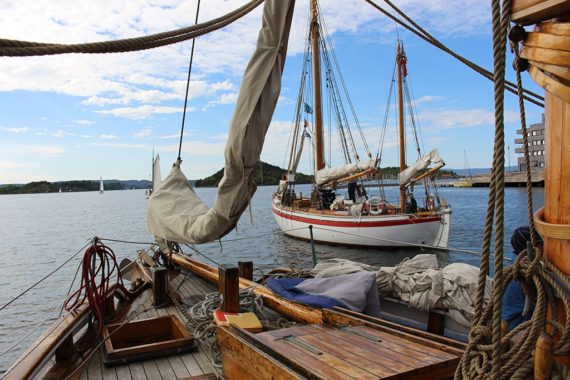
Futurefarmers is a group of artists and designers working together since 1995. We are artists, researchers, designers, farmers, scientists, engineers, illustrators, people who know how to sew, cooks and bus drivers with a common interest in creating work that challenges current social, political and economic systems. Our design studio serves as a platform to support art projects, an artist in residency program and our research interests.
Dylan Gauthier (b. Santa Monica, CA) is an artist, curator, and writer who works through long-form projects to engage with ideas of ecology, architecture, collectivity, time, media and networks, participation and utopian systems. Gauthier holds an MFA in Integrated Media from Hunter College at the City University of New York (CUNY), where he currently teaches courses in emerging media (theory and production).
Gauthier has participated in exhibitions and presented projects at the International Studio and Curatorial Program (ISCP), the Carpenter Center for the Visual Arts at Harvard University, EFA Project Space, MoMA PS1, MASS MoCA, the Walker Art Center, the Bronx Museum, Flux Factory, Stacion Kosovo, the Chimney, Parsons/the New School, the Columbus College of Art and Design, 80WSE Gallery at NYU, and the Neuberger Museum of Art at SUNY Purchase. He was the 2015 NEA supported Ecological Artist-in-Residence at ISCP, a resident at the Blue Mountain Center, and a visiting artist at Haverford College, as well as at the Institute for Hautes Études en Artes Plastiques (iheap) in Paris and New York City. Gauthier was the inaugural artist-in-residence at the Brandywine Conservancy & Museum of Art, an Emerging Artist Fellow at Socrates Sculpture Park, and a 2016 CAS Resident.


